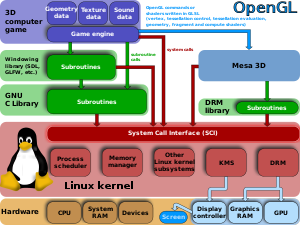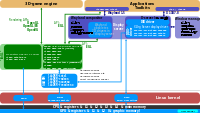Mode setting

Mode setting is a software operation that activates a display mode (screen resolution, color depth, and refresh rate) for a computer's display controller by using VESA BIOS Extensions or UEFI Graphics extensions (on more modern computers).
The display mode is set by the kernel. In user-space mode-setting (UMS), the display mode is set by a user-space process.
Kernel mode-setting is more flexible and allows displaying of an error in the case of a fatal system error in the kernel, even when using a user-space display server.
User-space mode setting would require superuser privileges for direct hardware access, so kernel-based mode setting shuns such requirement for the user-space graphics server.
Implementation
[edit]For "old" cards, support might change from distribution to distribution according to random criteria without apparent reson leaving the card unsupported[1].
Microsoft Windows
[edit]Microsoft Windows versions that are NT-based use kernel mode setting. The kernel error display made possible by kernel mode setting is officially called "bug check", but more commonly known as the Blue Screen of Death.
Linux
[edit]
The Linux kernel got the prerequisite for kernel-based mode setting by accepting Intel GEM in version 2.6.28, released in December 2008.[2] This will be[needs update] replaced by Tungstens Graphics TTM (Translation Table Maps) memory manager which supports the GEM API.[3] TTM was developed for the free and open-source drivers for Radeon and S3 Graphics graphic chipsets (see Free and open-source graphics device driver).[4] Support for Intel GMA graphic chipsets was accepted in version 2.6.29, released on March 23, 2009.[5] Support for pre-R600 ATI Radeon graphics cards was accepted in version 2.6.31, released on September 9, 2009.[6] Support for R600 and R700 was in development within DRM and was merged in version 2.6.32.[7] Support for Evergreen (R800) was merged in version 2.6.34. As Nvidia did not release all the needed documentation for its graphics chip, development proceeded under the nouveau project, which uses reverse engineering to build a working open-source driver for Nvidia cards. Nouveau was accepted in version 2.6.33 of the kernel, released on December 10, 2009. Kernel-based mode setting is not only supported by the nouveau driver, it is required.[8] Wayland compositors (e.g. Weston) and kmscon depend on kernel mode setting via ioctl.
FreeBSD
[edit]FreeBSD has support for both kernel-based mode setting and GEM for later generations of Intel GPUs (IronLake, SandyBridge, and IvyBridge) starting with version 9.1.[9]
Support of Intel card is limited. Some random Intel cards such as Device 'Intel CometLake-S GT2 [UHD Graphics 630]' does not work with FreeBSD[10]. Some cards where driver is supported but not supported actively and does not work suffer such kind of issues[11].
NetBSD
[edit]NetBSD has support for kernel-based mode setting and accelerated graphics for Intel and Radeon devices. This implementation was introduced in version 7.0 by porting the Linux 3.15 DRM/KMS code.[12]
OpenBSD
[edit]OpenBSD has kernel-based mode setting support for Intel and Radeon GPUs. Starting with version 5.4 of OpenBSD, support for Intel GPUs is available. With the release of version 5.5, the implementation has been extended to add support for Radeon chipsets as well.
Alternatives
[edit]This section needs to be updated. (August 2014) |
The following alternatives have been presented during the Linux Plumbers Conference 2013:
- It was suggested to split GEM and KMS.[13]
- Atomic Display Framework, by Google's Android-Team.[14][15]
- Common Display Framework.[16]
See also
[edit]References
[edit]- ^ https://linux-hardware.org/index.php?id=pci:8086-9bc8-1043-8694
- ^ "Linux 2 6 28". Linux Kernel Newbies. Retrieved 2013-02-14.
- ^ Larabel, Michael (2008-08-26). "A GEM-ified TTM Manager For Radeon". Phoronix. Retrieved 2013-02-14.
- ^ Larabel, Michael (2009-06-10). "TTM Memory Manager Gets Ready For Release". Phoronix. Retrieved 2013-02-14.
- ^ "Linux 2 6 29". Linux Kernel Newbies. Retrieved 2013-02-14.
- ^ "Linux 2 6 31". Linux Kernel Newbies. 2009-09-09. Retrieved 2013-02-14.
- ^ Larabel, Michael (2009-09-30). "AMD R600/700 2D Performance: Open vs. Closed Drivers". Phoronix. Retrieved 2013-02-14.
- ^ "nouveau/ KernelModeSetting". freedesktop.org. 24 August 2013. Retrieved 2014-08-11.
- ^ "FreeBSD 9.1-RELEASE Release Notes". FreeBSD Foundation. 30 December 2012.
- ^ https://bsd-hardware.info/?id=pci:8086-9bc8
- ^ https://dgpu-docs.intel.com/devices/hardware-table.html#gpus-with-unsupported-drivers
- ^ "Announcing NetBSD 7.0". The NetBSD Project. 25 September 2015. Retrieved 25 April 2016.
- ^ "Splitting DRM/KMS device nodes / Linux Plumbers Conference: Developing the Kernel, Libraries and Utilities". www.linuxplumbersconf.org. Archived from the original on 2013-10-30.
- ^ "Atomic Display Framework / Linux Plumbers Conference: Developing the Kernel, Libraries and Utilities".
- ^ "KMS HWComposer issues, the Atomic Display Framework and other KMS Extentions [sic] / Linux Plumbers Conference: Developing the Kernel, Libraries and Utilities". Archived from the original on 2015-08-31. Retrieved 2013-08-29.
- ^ "Common Display Framework / Linux Plumbers Conference: Developing the Kernel, Libraries and Utilities". www.linuxplumbersconf.org. Archived from the original on 2016-03-12.
External links
[edit]- Mode Setting on the X.org wiki
- Intel Graphics Driver on the X.org wiki
- ATI Radeon driver on the X.org wiki
- Kernel Mode Setting on the Fedora project wiki


